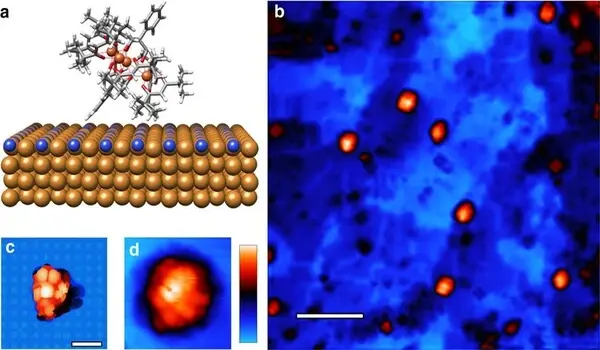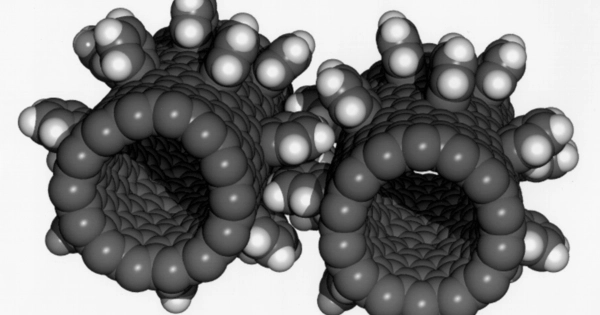The use of matter on an atomic, molecular, and supramolecular scale for industrial purposes is known as nanotechnology, also abbreviated as nanotech. The first widely accepted definition of nanotechnology referred to the specific technological goal of precisely manipulating atoms and molecules for the fabrication of macroscale products, which is now known as molecular nanotechnology.
In the field of molecular magnetism, the design of devices with nanoscale technological applications – quantum computing, molecular spintronics, magnetic cooling, nanomedicine, high-density information storage, and so on – necessitates the preservation of magnetic molecules placed on the surface.
Now, a paper published in the journal Coordination Chemistry Reviews examines the most recent knowledge on the processes of magnetic molecule deposition and organization on surfaces (nanostructuring), a determining process for the advancement of technologies involving engine miniaturization and more efficient operation in nanometric dimensions.
The study, signed by Carolina Saudo, Guillem Gabarró-Riera, and Guillem Arom from the Group of Magnetism and Functional Molecules of the Faculty of Chemistry and the Institute of Nanosciences and Nanotechnology of the University of Barcelona (IN2UB), describes the global scenario of research progress in this field and proposes new ways to make advances in the organization in two dimensions (2D) of magnetic molecules, regarding its technological applications.
The article includes recommendations for choosing the best deposition method for each molecule, as well as a review of the surfaces used in these processes, guidelines for effective characterization, and future perspectives based on bidimensional materials. Moreover, the authors provide a new critical perspective on how, in a near future, to reach the effective application of the molecular systems in a device to get a faster technology using less energy.
The top method depends on the system, but it will always be possible to find a proper combination to deposit the molecular systems. The protocols vary in each case and the first step is to determine the desired characteristics of the surface.
Carolina Saudo
Molecular nanoscience and magnetic materials
In order to select the best deposition method on surfaces for each magnetic molecule, we must consider each molecule and its structure, as well as the surface and structure it has. “The top method depends on the system, but it will always be possible to find a proper combination to deposit the molecular systems,” says UB lecturer Carolina Saudo.
“The protocols vary in each case and the first step is to determine the desired characteristics of the surface,” she continues. “For example, if we want to study spintronics, we will need a conducting surface. Once the surface and its nature have been determined, it is essential to determine the shape anisotropy of the molecule while looking at its crystalline structure, its properties — can it sublimate? can it dissolve? in which solvents? – and potential anchor points – does it have functional groups that allow chemisorption, and if it doesn’t, what are the options for physisorption?
If not, what are the physisorption options? Once we have all these details, we can design a deposition protocol. For example, if our molecule has an available sulfur group, we can anchor it by chemisorption to a gold (Au) surface. If the molecule can undergo sublimation, we can do it by evaporation,” she concludes.

Smaller and more efficient electronic devices
The synthesis of new molecules with better properties is an unstoppable process, “but stability does not always go hand in hand with magnetic properties. Right now, the molecule with the highest blocking temperature T – below which the molecule behaves like a magnet is extremely unstable. In particular, it is an organometallic compound and this makes it very difficult (or impossible) to place it on the surface or use it in a technological device.”
The stability of new organometallic monomolecular magnets (SMMs) must be improved if they are to be used effectively in order to improve the design of magnetic molecules and obtain more efficient surface deposition processes. Magnetic molecules that are not so good SMMs or quantum bits (qubits) or molecules with spin-allowed electronic transitions, on the other hand, have features that make them very difficult to use due to a lack of or little anisotropy in their shape or multiple anchoring functional groups that allow for diverse molecule depositions on the surface.
“To avoid this, it is necessary to advance the organization of D2 molecules. For example, by forming two-dimensional organometallic materials (MOFs) in which the nodule is the molecule, and depositing the nanolayers that are already implicitly ordered on a surface. A 2D MOF, where each nodule is a qubit, would allow us to obtain an array of ordered qubits on a surface. This is a very important challenge and some groups like ours are working on it,” the researcher says.
Another goal of surface deposition technology is to reduce the energy consumption of technological devices. “If we have a device that stores information in SMM, or we use qubits in a perfectly ordered 2D matrix, or a system with spin-enabled electronically transition—enabled molecules on a surface by molecular spintronics, the designed devices can have very low power consumption, she continues. Furthermore, they would be faster and smaller than current devices.”
In this field, the synthesis of inorganic compounds has generated magnet molecules that can function at temperatures around liquid nitrogen, “and this has been a major breakthrough,” says the researcher. Technologies such as tunneling microscopy (STM) and atomic force microscopy (AFM) with functionalized tips are the techniques that have made it possible to identify the position of the molecules on the surface. In particular, AFM with functionalized tips can become a very useful technique to characterise surface molecules.
“The discovery that a few nanometres of magnesium oxide (MgO) layer are required to decouple the molecule from the surface in order to maintain molecular properties once the molecule is deposited is a significant breakthrough.” It is also worth noting the coating of large surface areas with monolayers of molecules with a high percentage of order, because different molecule arrangements on the surface can produce different interactions and, as a result, not all molecules retain their properties. These two points are critical for future device development based on molecules deposited on surfaces” Carolina Saudo says.
Magnetic molecules: future challenges
For now, obtaining SMMs at elevated temperatures, or synthesizing qubits with longer relaxation times (T1) and coherence times (T2) that facilitate use in larger devices, is a challenge for chemists. Being able to obtain large areas coated with monolayers of equal and ordered molecules will also represent very relevant progress, and this challenge includes characterization. For this reason, the application of synchrotron light techniques – such as GIXRD, HAXPES, and XMCD — will be essential.
“The UB Group of Magnetism and Functional Molecules is considering using 2D MOFs, which are coordination polymers that extend in two dimensions and are made up of extremely thin layers stacked by Van der Waals forces, to achieve this order of molecules on the surface. Our team also wishes to address other issues, such as measuring the T1 and T2 relaxation times of a qubit deposited on a surface and confirming that the measured values are maintained (or improved) “The researcher draws a conclusion.





